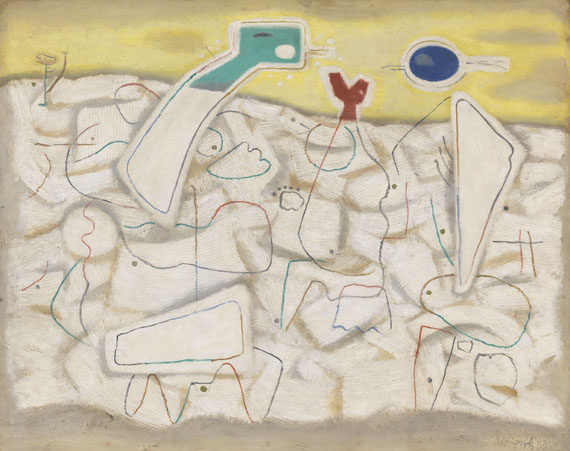201
Willi Baumeister
Helle Bewegung 3, 1947.
Oil
Estimation:
€ 100,000 / $ 116,000 Résultat:
€ 152,500 / $ 176,900 ( frais d'adjudication compris)
Helle Bewegung 3. 1947/48.
Oil with synthetic resin and filler on board reinforced with beams.
Beye/Baumeister 1364, worked over (the archive photo in the catalog raisonné shows an earlier state). Signed and dated lower right, scratched into wet paint. Dated, titled "Helle Bewegung 3" on verso and with dimensions as well as inscribed "Zum Umtausch nach Mannheim Galerie Günther Lange Rötterstr. 20" by a hand other than that of the artist . 64 x 81 cm (25,1 x 31,8 in).
Signature and date are partly covered by the artist's later overpainting.
We are grateful to Felicitas Baumeister and Hadwig Goez, archive Baumeister Stuttgart, for their kind expert advice.
PROVENANCE: Galerie Egon Günther, Mannheim.
Private collection, Berlin.
EXHIBITION: Gegenstandslose Malerei in Deutschland, Städtische Kunsthalle Mannheim, Mannheim 1952, cat. no. 8.
LITERATURE: Will Grohmann: Willi Baumeister. Leben und Werk, Cologne 1963, catalog raisonné no. 1002 (there titled "Helle Bewegung V").
During his apprenticeship as a decorative painter Willi Baumeister already visited evening classes at the Stuttgart Kunstakademie. From 1909 to 1912 he attended Adolf Hölzel's composition class where he first met the later Bauhaus painter Oskar Schlemmer who was to become a life-long friend. In 1919/20 he produced his first 'Mauerbilder', panels with a wall-like relief structure - created by adding sand and putty to the paint - and cubist forms. These works brought about Baumeister's international breakthrough. In 1928 the Frankfurt Städelschule appointed the artist to run the applied arts, typography and fabric printing class. Baumeister joined the 'Cercle Carré' in 1930 and in 1931 he became a member of 'Abstraction Création'. During the 'Third Reich' Baumeister was banned as a 'degenerate' artist and rarely showed himself in public. During the war Baumeister wrote the book 'Das Unbekannte in der Kunst' (The Unknown in Art) which was first published in 1947.
The relief-like surface, which breaks the light and makes for spatial depth in this composition, was a new and unusual element in Willi Baumeister’s art. The forms‘ relief-like structure is stacked like a wall and broken by linear elements upstriving forms. Like an intermezzo, Baumeister visualizes musical forms, creating a "helle Bewegung" (light movement) in its easy carefreeness. Having escaped the confinement of a doctrine, Baumeister was able to unfold his very own thoughts on a new and wide open field.
He resumed teaching after the war when he accepted a post at the Kunstakademie in Stuttgart. With his extensive oeuvre and his art-theoretic publications Baumeister is considered one of the most important modern German artists. His varied oeuvre ranges from figurative works at the beginning to increasingly abstract forms. [KD].
Oil with synthetic resin and filler on board reinforced with beams.
Beye/Baumeister 1364, worked over (the archive photo in the catalog raisonné shows an earlier state). Signed and dated lower right, scratched into wet paint. Dated, titled "Helle Bewegung 3" on verso and with dimensions as well as inscribed "Zum Umtausch nach Mannheim Galerie Günther Lange Rötterstr. 20" by a hand other than that of the artist . 64 x 81 cm (25,1 x 31,8 in).
Signature and date are partly covered by the artist's later overpainting.
We are grateful to Felicitas Baumeister and Hadwig Goez, archive Baumeister Stuttgart, for their kind expert advice.
PROVENANCE: Galerie Egon Günther, Mannheim.
Private collection, Berlin.
EXHIBITION: Gegenstandslose Malerei in Deutschland, Städtische Kunsthalle Mannheim, Mannheim 1952, cat. no. 8.
LITERATURE: Will Grohmann: Willi Baumeister. Leben und Werk, Cologne 1963, catalog raisonné no. 1002 (there titled "Helle Bewegung V").
During his apprenticeship as a decorative painter Willi Baumeister already visited evening classes at the Stuttgart Kunstakademie. From 1909 to 1912 he attended Adolf Hölzel's composition class where he first met the later Bauhaus painter Oskar Schlemmer who was to become a life-long friend. In 1919/20 he produced his first 'Mauerbilder', panels with a wall-like relief structure - created by adding sand and putty to the paint - and cubist forms. These works brought about Baumeister's international breakthrough. In 1928 the Frankfurt Städelschule appointed the artist to run the applied arts, typography and fabric printing class. Baumeister joined the 'Cercle Carré' in 1930 and in 1931 he became a member of 'Abstraction Création'. During the 'Third Reich' Baumeister was banned as a 'degenerate' artist and rarely showed himself in public. During the war Baumeister wrote the book 'Das Unbekannte in der Kunst' (The Unknown in Art) which was first published in 1947.
The relief-like surface, which breaks the light and makes for spatial depth in this composition, was a new and unusual element in Willi Baumeister’s art. The forms‘ relief-like structure is stacked like a wall and broken by linear elements upstriving forms. Like an intermezzo, Baumeister visualizes musical forms, creating a "helle Bewegung" (light movement) in its easy carefreeness. Having escaped the confinement of a doctrine, Baumeister was able to unfold his very own thoughts on a new and wide open field.
He resumed teaching after the war when he accepted a post at the Kunstakademie in Stuttgart. With his extensive oeuvre and his art-theoretic publications Baumeister is considered one of the most important modern German artists. His varied oeuvre ranges from figurative works at the beginning to increasingly abstract forms. [KD].
201
Willi Baumeister
Helle Bewegung 3, 1947.
Oil
Estimation:
€ 100,000 / $ 116,000 Résultat:
€ 152,500 / $ 176,900 ( frais d'adjudication compris)




 Lot 201
Lot 201 